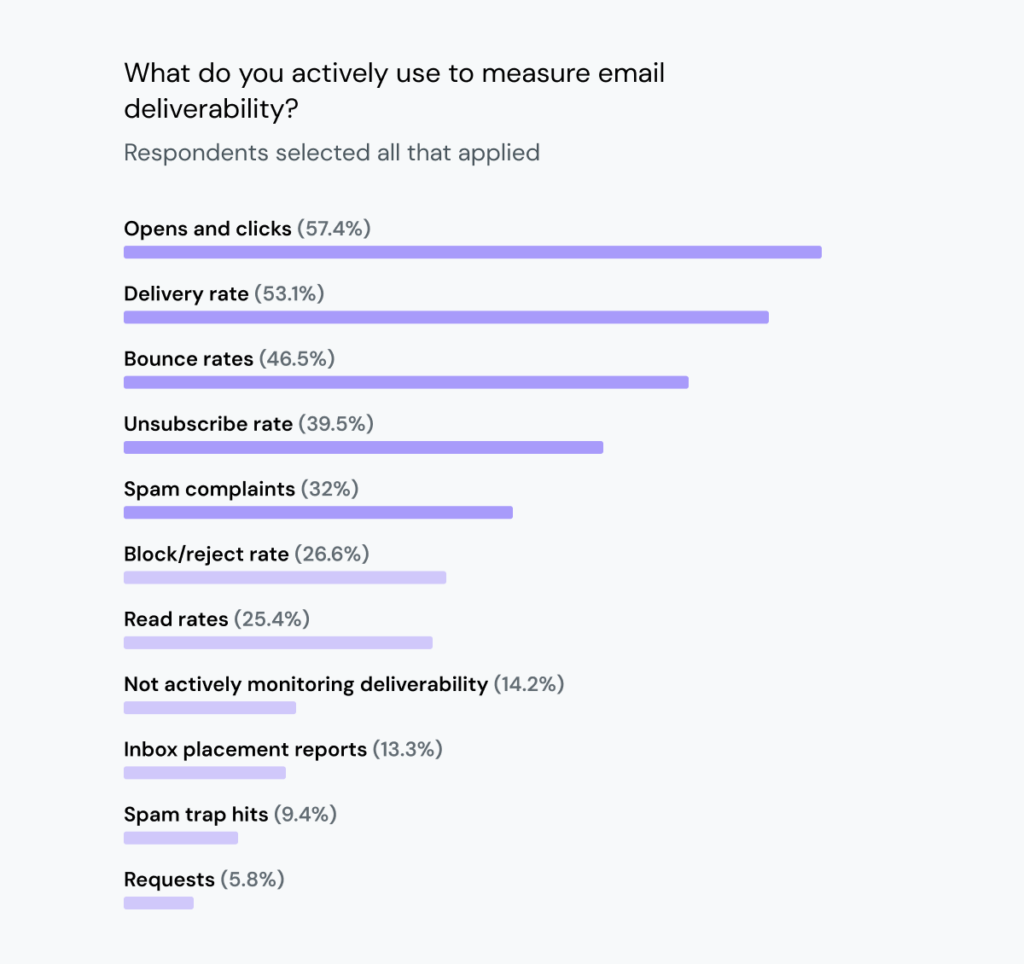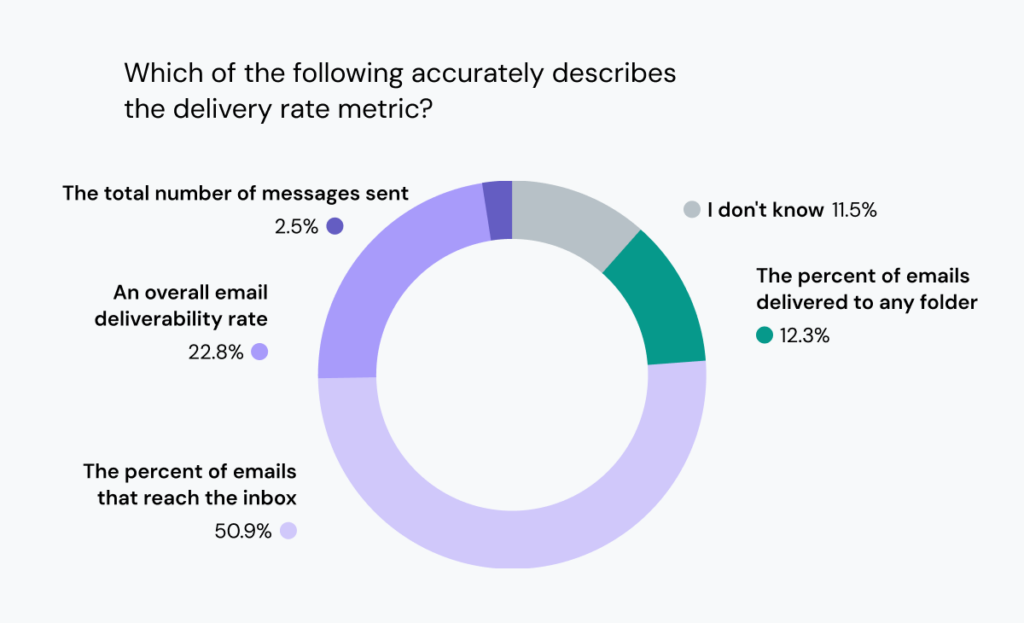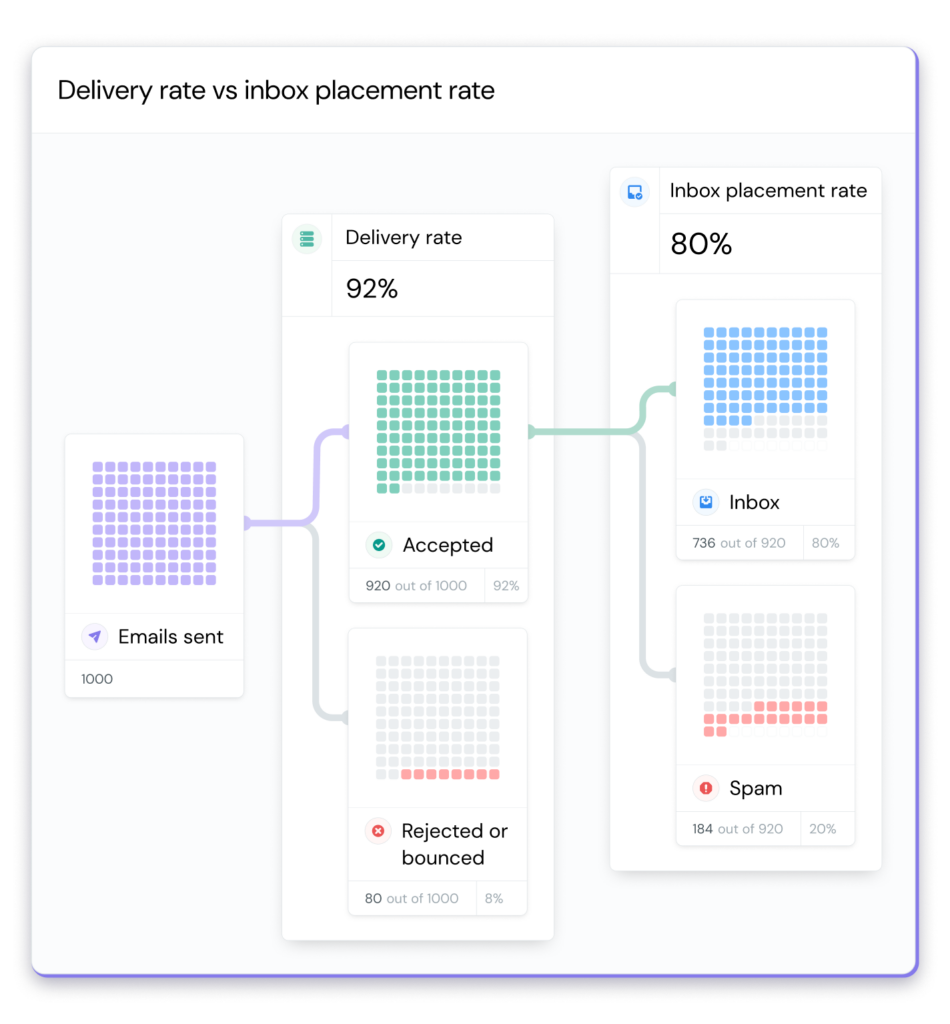Deliverability
The difference between email deliverability and your delivery rate

Deliverability

Language is a tricky beast. Take homonyms like sole and soul, for example. They sound the same, but one is on the bottom of your shoe, and the other is your eternal, non-physical essence. So, there’s a pretty big difference.
The same goes for the email delivery rate and email deliverability. They sound very similar, and while they’re somewhat related, they’re far from the same thing.
A survey of email senders around the world shows there’s a need to clear things up.
What happens to your emails after you hit the send button? There are plenty of things you can measure in email marketing, but some answers are easier to get than others. Measuring deliverability is one of the more perplexing problems.
Email is one of the most important customer communication channels, and its return on investment (ROI) can really pay off. Of course, you’ve got to get your emails delivered to inboxes for any of that to make a difference. And the definition of the word “delivered” in this context is causing problems.
Sinch Mailjet’s report on deliverability, Road to the inbox, includes survey results from email senders around the world. The research shows 86% of senders are monitoring email deliverability by tracking specific metrics.
57% of respondents say they’re watching open and click rates, which is a good way to know that emails are reaching contacts. Bot opens and clicks aside; you can’t open and click on an email without getting it delivered. Another 53% say they’re actively monitoring their email delivery rate to help measure deliverability.

While measuring your email delivery rate is worth doing, it only paints part of the deliverability picture. The part it leaves out might be what you care about most.
The email delivery rate measures the percentage of emails that receiving mail servers accept for delivery. A good average email delivery rate is typically above 95%.
However, if you get a 95% email delivery rate, it does not mean 95% of your messages reached the inbox. That’s because getting “delivered” could also mean your emails were filtered into the spam folder. Obviously, landing in junk is not good for deliverability.
Unfortunately, many people who are involved with email marketing strategy don’t realize what the delivery rate actually measures. In fact, Sinch Mailjet’s research found a combined 88% of senders couldn’t correctly define the email delivery rate metric.
More than half believe the delivery rate measures how many emails reach the inbox, and another 23% think it’s an overall deliverability metric. More than 11% were willing to admit they didn’t know the answer.
But only around 12% of those we surveyed know that the email delivery rate is the percentage of emails delivered to any folder (including spam).

If you’ve been looking at a 90% delivery rate and assumed it meant 9 out of 10 emails reached the inbox, this news may come as a shock. There’s no reason to be ashamed. You’re far from alone after all. It’s something senders need to get right, however, to get an accurate understanding of their ability to reach customers and contacts.
What the delivery rate does not measure is inbox placement. That’s actually an entirely different metric. The infographic below illustrates the difference:

As you can see, the delivery rate excludes any emails that bounce or get blocked because they’re never delivered. The inbox placement rate only gets calculated after messages are accepted for delivery. This measurement excludes the emails that landed in spam.
Let’s take a closer look at the equations used to calculate the email delivery rate vs inbox placement.
(Emails delivered ÷ Emails sent) x 100 = Email delivery rate
(Emails in the inbox ÷ Emails delivered) x 100 = Inbox placement rate
The delivery rate divides emails delivered by emails sent. The inbox placement rate divides the number of emails that reach the inbox by the number of emails delivered. This bears repeating… The delivery rate includes emails that end up in spam, but the inbox placement rate excludes them.
Sinch deliverability expert Renate Burns explains more about the difference between email deliverability and the delivery rate in the short video below.
If you’re poking around in the analytics from your email service provider, and you can’t find the inbox placement rate anywhere, there’s a reason. Most ESPs don’t provide these numbers.
The truth is, it’s impossible to calculate a literal email deliverability rate. There’s no way to get inside the various inboxes of every subscriber on your list to see how your messages are being filtered.
What you can do, thankfully, is get a very good estimate of overall deliverability through a pre-send process known as inbox placement testing. You may also see it referred to as “seed testing.” That’s because it involves using a variety of seed mailboxes from different providers to test what happens to those emails.
All this testing lets you know what’s likely to happen when you launch a real email campaign. Here’s Renate Burns again with a thorough explanation of how inbox placement testing works and why it gives you an advantage.
There’s another reason why conducting inbox placement testing is a good move… Sinch Mailjet’s Road to the inbox report found only around 13% of the senders we surveyed use inbox placement reports to help them measure email deliverability. If your competitors don’t know about this process, or fail to conduct these tests, it could give you a strategic advantage.
Find out more about inbox placement testing from the team at Sinch Mailgun. It’s just one part of their comprehensive deliverability platform, Mailgun Optimize.
Inbox placement reports may also be able to provide information about where emails are likely to land within the inbox – such as the Gmail Promotions tab.
Plenty of marketers have issues with ending up in the Promotions tab. They’d rather be in the main inbox, sandwiched between a birthday email from grandma and an unopened shipping update for toilet paper.
The Promotions tab is not the same as landing in spam. It’s part of the inbox and not a punishment. It’s a Gmail user experience enhancement. Bottom line? Getting filtered into the Promotions tab is not a bad thing.
People use tabbed inboxes to help bring some organization to all the clutter emails sometimes create. Are you sending promotional emails? Then that’s probably the right place for your campaigns to end up.
A B2C email marketing campaign that is filtered into Promotions is much less likely to get marked by the recipient as spam. The tab is exactly where they want to find it. That’s a good thing – because a high spam complaint rate will hurt email deliverability.
If you know how to develop emails, you could even optimize them for specific features of the Gmail Promotions tab. That includes things like product carousels, deal annotations, promotional end dates, and your brand’s logo.

Another encouraging fact about Promotions tabs? Plenty of consumers look at what’s inside regularly. Sinch Mailjet’s report The path to email engagement found that around 75% of people check the tab weekly and 50% visit the Promotions tab every day.
When they do visit that tab, guess what they expect to find? Interesting emails and deals from their favorite brands, that’s what.
Email deliverability vs the delivery rate isn’t the only thing that may cause confusion on your quest to reach customers and subscribers with marketing messages and more. Want to gain some expertise? Be sure to explore our full report, Road to the inbox: Navigating email deliverability in 2025. It’s 100% ungated and free. There’s no need to enter any contact information for access.
Find out more about everything from list building and hygiene to the direct connection between email engagement and sender reputation. You’ll discover how what you’re sending today can have a huge impact on your ability to reach inboxes tomorrow.
Send me the Sinch newsletter.